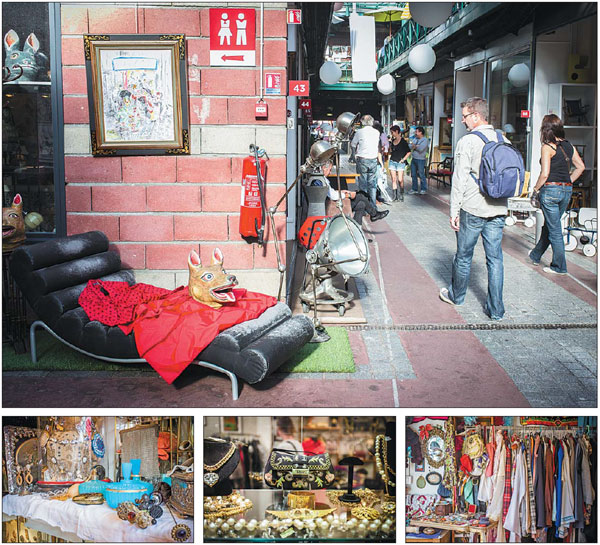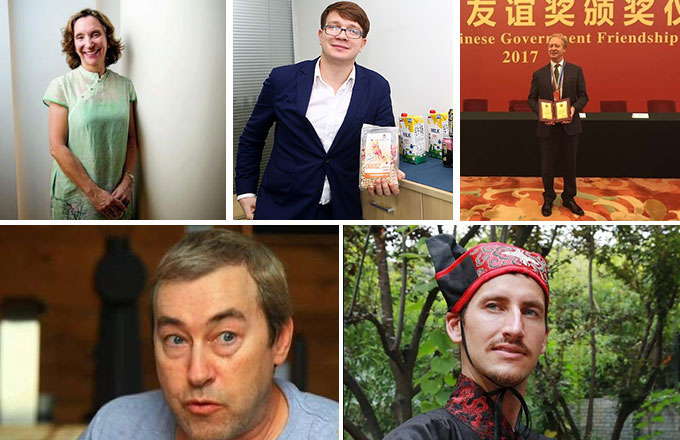At a Paris Flea Market, Tips for Treasure Hunters
|
Clockwise from top: The Marche Dauphine, one of the markets at Marche aux Puces de Paris/St.-Ouen; Anne Podgorny's shop at Marche Dauphine; a shop in Marche Serpette; Scenes from Marche Dauphine, where some of the best bargains can be found. Julien Bourgeois for The New York Times |
Good deals can still be had at some of the smaller shopping areas.
St.-Ouen. The name made me shudder. Whenever visitors asked me to take them to that vast set of flea markets just north of the Paris city line, I did my best to divert them elsewhere.
For me, getting to the March aux Puces de Paris/St.-Ouen was exhausting. It meant a ride on the No 4 Mtro line to the Porte de Clignancourt in the 18th Arrondissement and 15 minutes of jostling through a bazaar of cheap clothing, fabrics, leather goods, trinkets, cellphone covers, pots and pans.
St.-Ouen is so big (1,700 dealers in 14 markets spread over 228,600 square meters) that the only way to get around is with a map. Even then, I tended to end up in cul-de-sacs of oppressive, overpriced crystal chandeliers, marble mantel pieces, gilt-framed mirrors and Italian floor lamps in the shape of palm trees.
Then there was the bargain issue. There was a time when St.-Ouen was a place where tourists could hope to outwit the dealers. Decades ago, the columnist Art Buchwald wrote that it was a "hodgepodge of taste" where "one may find some precious thing the rest have overlooked, or he may have his pocket picked".
The part about finding some precious thing (cheap, that is) became much harder as rents soared, the dollar sank, dealers catered to wealthy foreigners and the antiques market turned digital. Having your pocket picked, however, was never a challenge.
So I preferred to take visitors to Puces de Vanves, the small, messy, open-air flea market on the opposite end of town, where bargains were still to be had. I showed them the proof: a 2-euro silver-plated gravy boat in the shape of a swan and a 10-euro cache of mismatched cut-crystal cordial glasses ($2.40 and $12, at $1.21 to the euro). I introduced them to the button man with thousands of Bakelite buttons sewn on to their original cards, and the woman with the collection of 10-euro cuff links.
I also logged on to vide-greniers.org, the website that announces weekly street markets. Vide-greniers literally means "empty the attics"; they range from residents participating in a neighborhood fair to itinerant professional dealers.
Then, over the last two years, St.-Ouen has become cool again, as a go-to weekend destination for young Parisians as well as foreign tourists. And not only for treasure-hunting.
The Iranian-born cameraman Darius Khondji made the flea market sparkle in Woody Allen's 2011 crowd-pleaser, Midnight in Paris. (In case you don't remember, Inez dips in and out of the stalls of March Paul-Bert-Serpette Puces de Paris St.-Ouen, the largest of the markets; Gil wanders off and makes the acquaintance of a French antiques dealer named Gabrielle who shares his passion for the Lost Generation. The message is clear: Anyone can go to Paris and find serendipity, beautiful objects and a soul mate.)
I discovered that it's as easy as pie to get straight to Rue Paul Bert, one of the main streets of St.-Ouen, from the Left Bank north through Montmartre on the Right Bank via the No 85 bus. It's a lovely way to see Paris. As for pickpockets, warnings throughout the market and armies of both local police officers and private security guards serve as deterrents.
Last year, the European furniture designer Habitat spearheaded a move to transform a spacious courtyard of old ateliers and warehouses on Rue des Rosiers across the street from Paul-Bert-Serpette into soaring, deluxe spaces that look more like small museums than retail shops.
Habitat 1964, as the 1,310-square-meter installation is called in honor of the year the company was founded, plays cool jazz and showcases furnishings no longer in production, including its 1977 Mushroom lamp and 1993 Altona desk. Beware the prices: A rare Pierre Paulin couch in sky blue was recently selling for 15,000 euros.
Another pioneer is L'Eclaireur, which opened its seventh Paris outlet in a former chandelier repair atelier here. It offers high-end contemporary furniture, sculptures and vintage haute couture clothing. Galerie Gam next door specializes in 20th-century French furniture design from the 1950s through the 1970s; Le White, in objects in, bien sr, white.
Also in the courtyard, Mademoiselle Steinitz's industrial warehouse mixes rare furniture, fantastical sculptures, contemporary photography and formal gowns. On a recent visit, a Viennese Arts and Crafts couch with two armchairs and two side chairs was 53,000 euros; a one-of-a-kind 1910 butterfly desk and chairs by the Belle poque fashion designer Paul Poiret cost 300,000 euros.
Nearby, three small early-20th-century houses on Rue Paul Bert are musts for lookers who may not be buyers. Un Singe en Hiver, covered with wisteria and ivy at No 6, features an inner courtyard with old stone crockery, a stone ostrich and antlers in a bowl. Sylvain Seron, who owns the space with his wife, Sylvie, will be eager to explain the history of the objects, including the construction of long metal tables from 19th-century industrial water tanks.
Up a stone staircase at La Petite Maison at No 10, Franois Casal also loves conversation, so much so that if you stay long enough he may offer you a glass of Champagne in a heavy crystal goblet. Ask him about the zinc-topped, marble-based bar with inlaid mother-of-pearl at the entrance.
My least favorite shop of the trio is Colonial Concept at No 8, although it is a taxidermist's delight, with more than a dozen stuffed peacocks, zebra heads, a stuffed leopard and a stuffed lion lying on its side; 4,500 euros will buy you a bearskin rug. Feather headdresses, white corals, polished fossils, a partial giraffe, assorted skulls, lamps made of ostrich eggs - all make it difficult for the environmentally correct visitor to embrace. Photographs are forbidden; the chilly welcome makes you wonder whether it wants customers at all.
St.-Ouen has become a better bad place to eat. For a snack or light lunch, La Buvette des Tartes Kluger in what was once a brick factory in the Habitat courtyard offers Kluger's wide assortment of homemade sweet and savory pies; lunch can be eaten on picnic tables outside.
Since 2012, there is also Ma Cocotte, a high-ceilinged, two-level brasserie designed by Philippe Starck. With several small dining rooms and two large terraces, it screams new, a contrast to the flea market's warrens of alleys. Without sufficient insulation, it also screams loud. The restaurant, which offers everything from caviar and foie gras to cheeseburgers and fish and chips, is open evenings during the week, even when the flea market is closed.
There are also the old-timers, like Caf Paul Bert for a reliable steak frites on Rue Paul Bert, and Le P'tit Landais on Rue des Rosiers for a slab of foie gras and green salad. A two-course lunch for two with wine at either place will cost around 35 euros, one of the best bargains at St.-Ouen.
In the past two years, about 50 shops have opened in Paul-Bert-Serpette, many by younger dealers. Mid-20th-century furniture, lighting and decorative arts in modern, unadorned spaces are popular, trendy and pricey.
Last spring, the Parisian media magnate Jean-Cyrille Boutmy bought Paul-Bert-Serpette. He has already implemented measures to guarantee the authenticity of the market's objects and is planning to spruce up the site.
Cyril Aouizerate, one of the founders of the Mama Shelter hotel in Belleville, in the 20th Arrondissement, is investing 40 million euros in a hotel that will open at St.-Ouen in 2016. To be called M.O.B., the 350-room hotel will include a cultural center with a bookstore, meditation rooms, an open-air movie theater and a vegetarian restaurant serving organic, local produce.
For visitors who want to shop as well as look, all is not lost. Here is a rundown of some of my affordable favorites (or at least where good value can be found).
The perfect scarf: Vintage Herms scarves, many of them decadesold and in the softest of silks, start at 160 euros at Le Monde du Voyage in March Serpette. Helen and Alain Zisul also offer a selection of perfectly preserved Louis Vuitton trunks.
Paintings: Post-Cubist gouaches in oak frames by the little-known painter Jacques Marly (1885-1965) start at 950 euros. Marly painted only for pleasure during his life; his grandniece Josette Revellin has begun to sell a few at a time at March Serpette.
Old kitchenware: Call on Franois Bachelier at Bachelier Antiquits at March Paul Bert for enamel scales, heavy copper pots, enameled metal animal prize medallions, tin molds, advertising signs, kitchen utensils, southwestern French pottery jugs and pitchers and winemaking paraphernalia. At 350 euros, the 1-meter-high, cast-iron apparatus in fire-engine red to cork wine bottles was a steal.
Old paper: Take a detour to Paul Maurel in March Vernaison at St.-Ouen. For 35 years, the shop has offered old travel posters, maps and flower and animal prints.
Costume jewelry: If you're longing for native English speakers, also in the March Vernaison is Au Grenier de Lucie. Jason and Heidi Ellis gave up their jobs as sports coaches, sold their London home to move to Paris and opened up a vintage jewelry and accessories shop five years ago. If you're not tempted by the alligator handbags, try a rhinestone tiara.
Old postcards and photographs: Take another detour up an escalator to the March Dauphine and call on Philippe Rault just inside the entrance. Try out his stereoscopes for a look at early 3-D. And at 15 euros apiece, you might walk away with the perfect gift: a 60-year-old aerial photo of a Paris neighborhood. If you're not worn out, head into the main Dauphine area for some of the market's best bargains.
But if such a singular adventure sounds exhausting, hire a guide to do all the work - and price-negotiating - for you. Henry Personnaz, a French interior designer, has made a hobby of giving small private tours of St.-Ouen. He can customize them to suit your tempo and your taste for any object - from a 19th-century oil painting to an Art Deco silver table setting.
If you want a brasher, nonstop, more American approach, contact Rachel Kaplan. She loves to show you what she calls "the deals"; she hates being interrupted.
"You know what I call the flea market?" she told a mother, daughter and grandmother on a private tour. "The Louvre - except you can go shopping."
Some may call that the perfect Paris outing.
The New York Times



















